Experiments with Visible and Near-Infrared Light
Explore the reflection, transmission, absorption, and emission of visible and near-infrared light using inexpensive and readily available equipment. Examples of experiments follow, but there are unlimited possibilities. Share your experiments in the Comments section below!
Filters
Plant Stress Detection Filters
Plants use red and blue light to photosynthesize. If these were mixed (explore how with Color Vectors), we would see magenta. If a plant is unhealthy or stressed, it absorbs less light for photosynthesis, so it reflects more red and blue light. A magenta filter lets red and blue light through but absorbs green light. If you looked at plants through a magenta filter, healthy plants would appear dark (little reflected red and blue light), and stressed plants would appear brighter. Foresters use plant stress detection glasses to monitor the health of trees.

A photograph of a mix of healthy and stressed leaves in visible light.
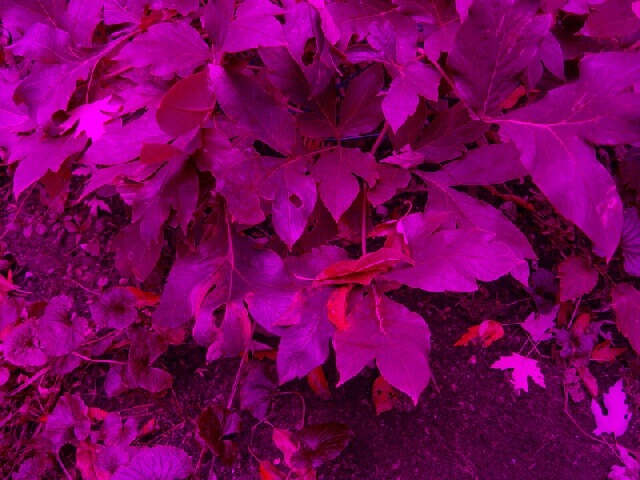
The same healthy and stressed leaves looking through a magenta filter. Stressed parts of leaves are easier to see since they are lighter than the healthy leaves.
Near-Infrared Goggles
Build near-infrared goggles for under $10! Yes, our eyes can see just into the near-infrared (NIR) spectrum, but we need to block out most of the visible light. Here is an inexpensive way to see things we usually can’t!
The landscape image below left is what you would see when looking through a red filter, and the image on the right is what you would see using the NIR goggles. None of the objects in the picture are emitting any red light or NIR. Dark red colors show materials reflecting little of that spectrum (so are highly absorbent), and bright red indicates that the material was quite reflective. Notice how the leaves, sky, and pavement reflect different amounts of red light and NIR.
Why do we see red when using the NIR goggles? Infrared doesn’t have a color in human vision! But our eyes have three color detectors: red, green, and blue. And only the red sensors can see a portion of the NIR, so our eyes tell our brain that everything is in shades of red. Use the goggles to look at the black fabrics you use in the experiment available below. You will then be able to use them to pick the clothes you wear outside to keep warm or cool, depending on the season and your preference.
Caution
The world is mesmerizing to look at through near-infrared goggles! But there are two cautions:
- Do NOT look directly at the Sun.
- Do not wear these indoors while walking – you will most likely trip on objects that are in the shadows.
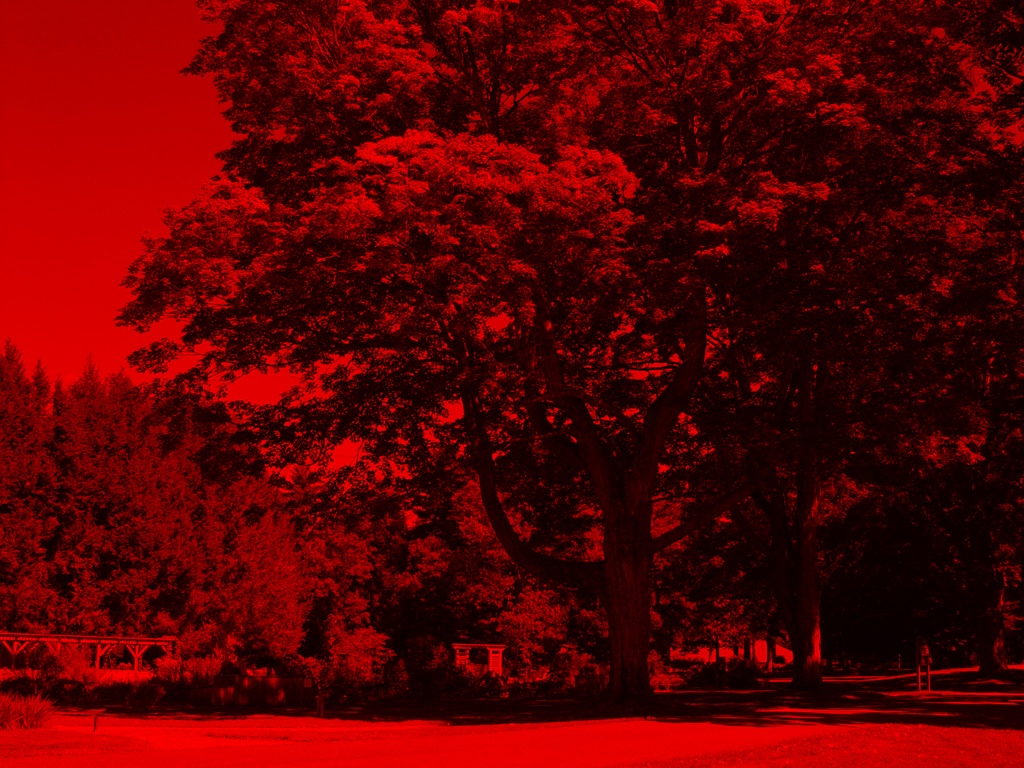
Red light reflected in a landscape. Dark objects either reflected little red light or are in shadows.
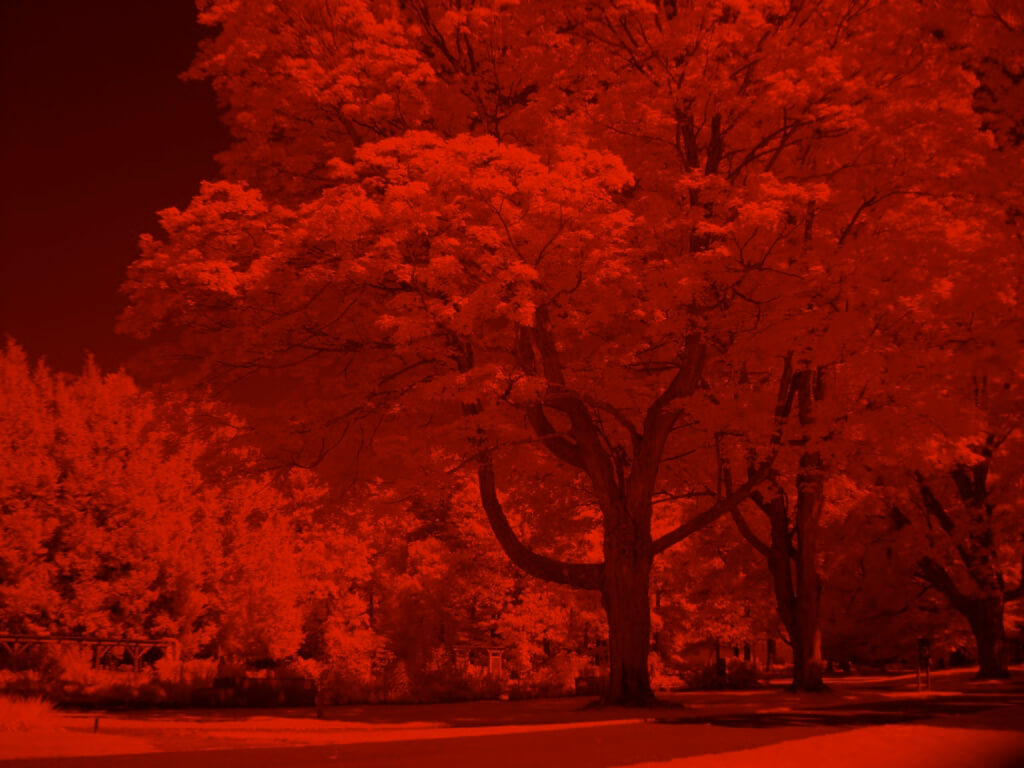
Near-infrared reflected in the same landscape as above. Dark objects either reflected little near-infrared or are in shadows.
Low-Cost Filter Booklets
Buy a booklet containing over 100 color filters for as little as $1.50 (search the Internet for the best price) and explore your world. Some examples of color lenses sold commercially are:
- Reduced eye stress while working on your computer,
- Improve your vision while playing golf, and
- Improve vision in low-light and hazy conditions.
Polarized Sunglasses
If you have a pair of polarized sunglasses, take them off and rotate them while looking through them. Depending on its orientation, polarized light will change intensity depending on the orientation of the lenses. You can explore the polarization of the scattered blue light in the sky and see how bees use it to navigate. Discover which plants reflect polarized light (helping bees and butterflies find them more efficiently), and even identify how human skin is healing from a wound over time.
Photometers
Photometers measure the intensity of light reaching the sensor. They may be classified as broad-spectrum, or their capabilities may be limited to a small range of wavelengths. An inexpensive device that measures light intensity for a relatively narrow range of wavelengths is a light-emitting diode (LED) connected to a voltmeter. We usually use LEDs to generate light by running a current through them. Interestingly, shine a light of similar wavelengths onto the LED to produce electricity. This is how our remote controls work: one LED emits pulses of near-infrared, and a receiving LED converts the light pulses to electric signals.
Explore measuring reflected and transmitted light with LEDs with these activities.
Read more on using LEDs as light detectors.

An LED connected to a voltmeter is an inexpensive photometer that measures light intensity.
Digital Cameras
If you try the LED photometer activities, you will appreciate how much time it takes to collect and analyze several measurements. A digital camera contains millions of photometers that collect spatially organized red, green, and blue intensity measurements in a blink of an eye. These data are easily shared with and analyzed on your computer. Depending on your creativity, study the reflection, transmission, absorption, scattering, refraction, diffraction, and polarization by objects.
And we aren’t done – digital cameras may be modified to photograph in the near-infrared and ultraviolet wavelengths.
Plus, most digital cameras have a video mode, so you are able to capture 30, 60, or more frames per second, all providing spatially organized light intensity measurements. Extremely modified digital cameras capture the propagation of light!
Because the data are spatially organized, we can do more than just study light intensities. We can study the size, shape, orientation, movement, acceleration, texture, position, and behavior of an object with digital cameras. Not bad for a device that is found on every smartphone today!

To help make more detailed measurements, a scale for size, color, orientation, or other variable being measured may be included in the image or video.
Is a Digital Camera the Ultimate Experimental Tool?
Using the concept map showing the ways a digital camera may be used to collect light measurements, you can design over 2300 experiments to study not just light, but the processes that created the patterns of light captured in the image. Not too shabby!
Key Concepts to Consider
- When using visible light, a digital camera captures intensities of red, green, and blue light simultaneously. See Color Vectors to explore how red, green, and blue light create the colors we see.
- A digital camera’s light sensor detects ultraviolet (UV), visible light, and near-infrared (NIR), but internal filters block the UV and NIR from reaching the sensor. These filters may be removed so the camera may take photos in the UV or NIR, opening up ways to view (and measure) what humans cannot do with their eyes.
- The ways light interacts with matter (reflection, transmission, absorption, and emission) depend on the chemical and physical properties of the material. Therefore, the light measurements captured by the camera tell us about these properties.
The video that follows provides a few examples of how to use a digital camera in science.
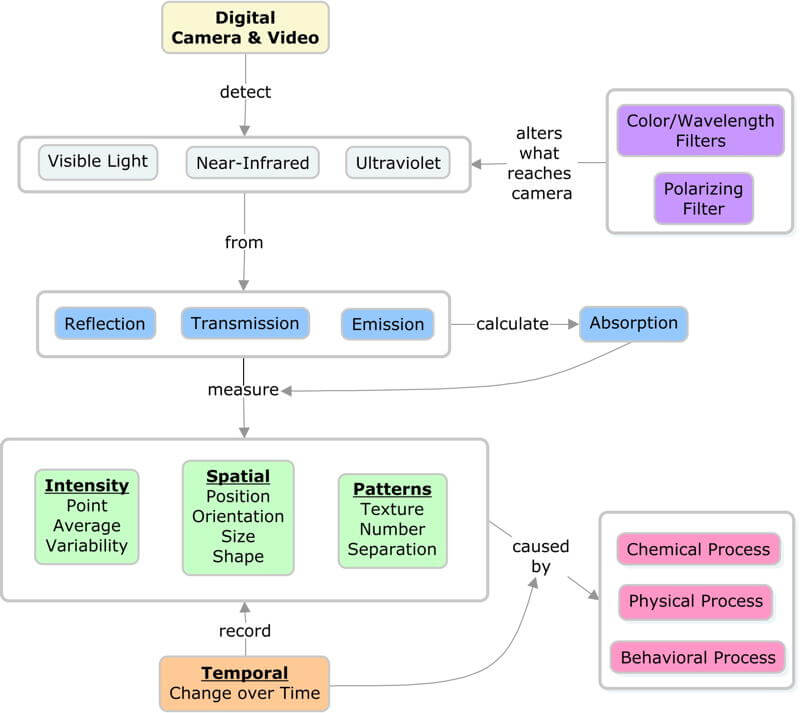
Above is a concept map of how to use a digital camera and video to create experiments in which the primary source of data are light measurements.
Unfortunately, with changes in computer operating systems, the MovieTracker software referenced in the video no longer works on today’s computers.

A landscape photographed in visible light. There are three overlapping layers of color intensity measurements in the image: red, green, and blue.
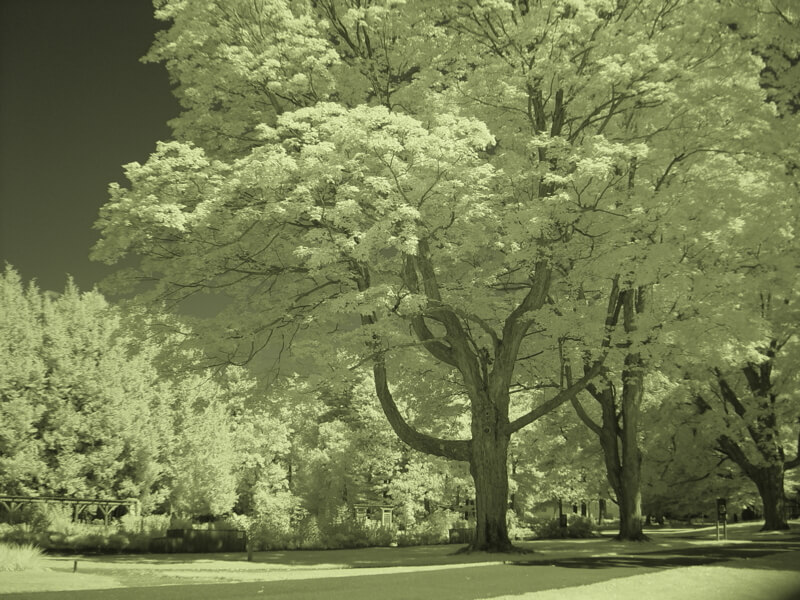
The same landscape photographed in near-infrared. Dark objects either reflected little near-infrared or are in shadows.
Black Fabrics Experiment
A black cloth absorbs most of incoming visible light, but does this mean that all other wavelengths of radiation will be absorbed? As we saw with red light and NIR images for the near-infrared goggles, materials interact with parts of the spectrum of radiation differently. But how do these different amounts of absorption affect the energy budget of an object? To the right are images of three black fabrics. The top image is in visible light and the bottom in NIR. Which do you think will warm up more when illuminated by both visible light and NIR? Try the black fabric experiment to find out.
The data are also available in the Blackbody Radiation software.
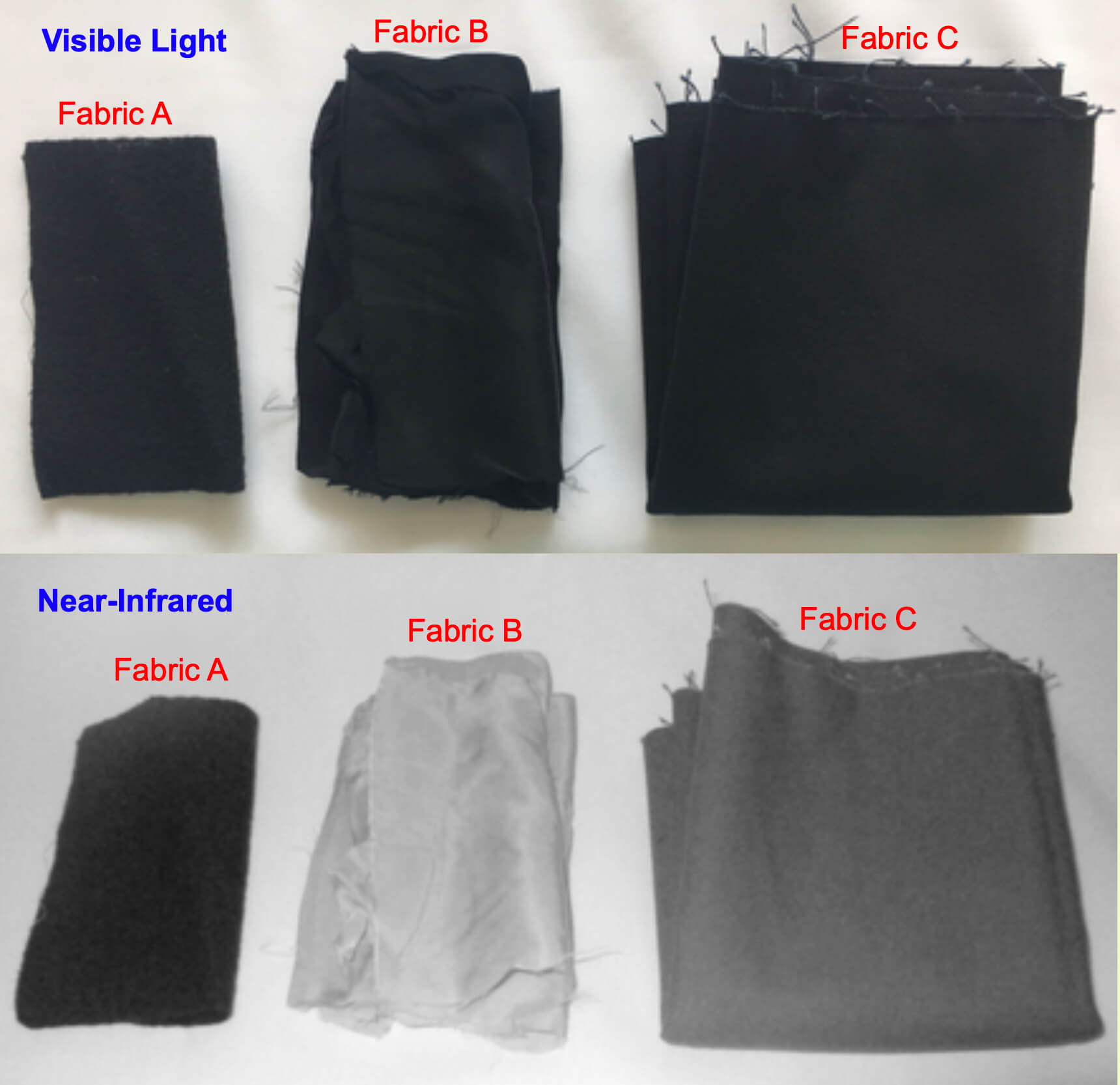
Three black fabrics in visible light (top) and near-infrared (bottom). Dark objects absorb those wavelengths, and lighter objects reflect more.
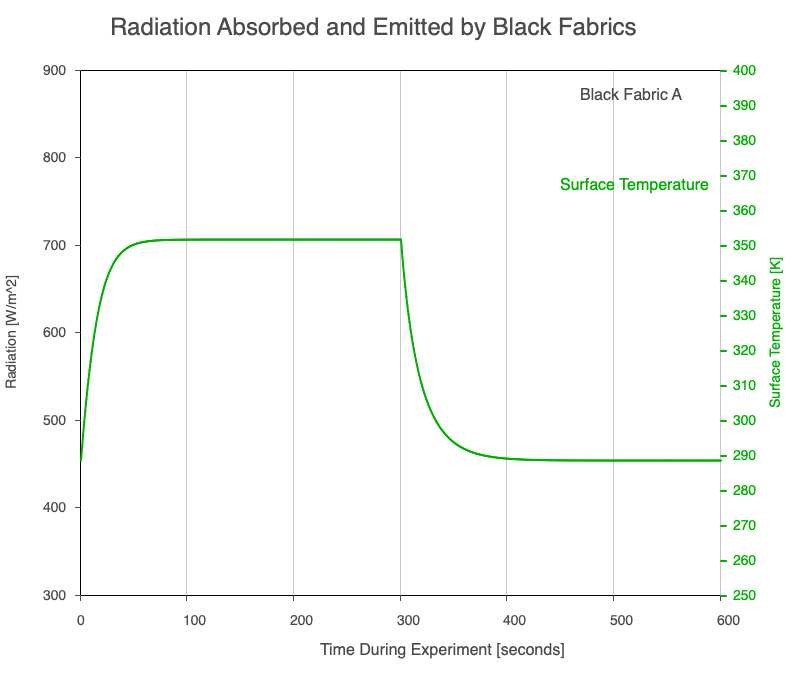
The temperature of the black fabrics shown in visible and near-infrared (shown on the left) over time. The light is on for the first 5 minutes (300 seconds) and turned off during the last 5 minutes.
Black Clothes in Your Wardrobe?
If you like wearing black or dark clothing but hate being hot in the summer, consider building a pair of near-infrared goggles. Scan your clothing to see which will stay cool in the summer – or warm you up in the winter!
Big Ideas
- There are nearly unlimited experiments to explore the reflection, transmission, absorption, and emission of visible and near-infrared light using inexpensive and readily available equipment.

0 Comments